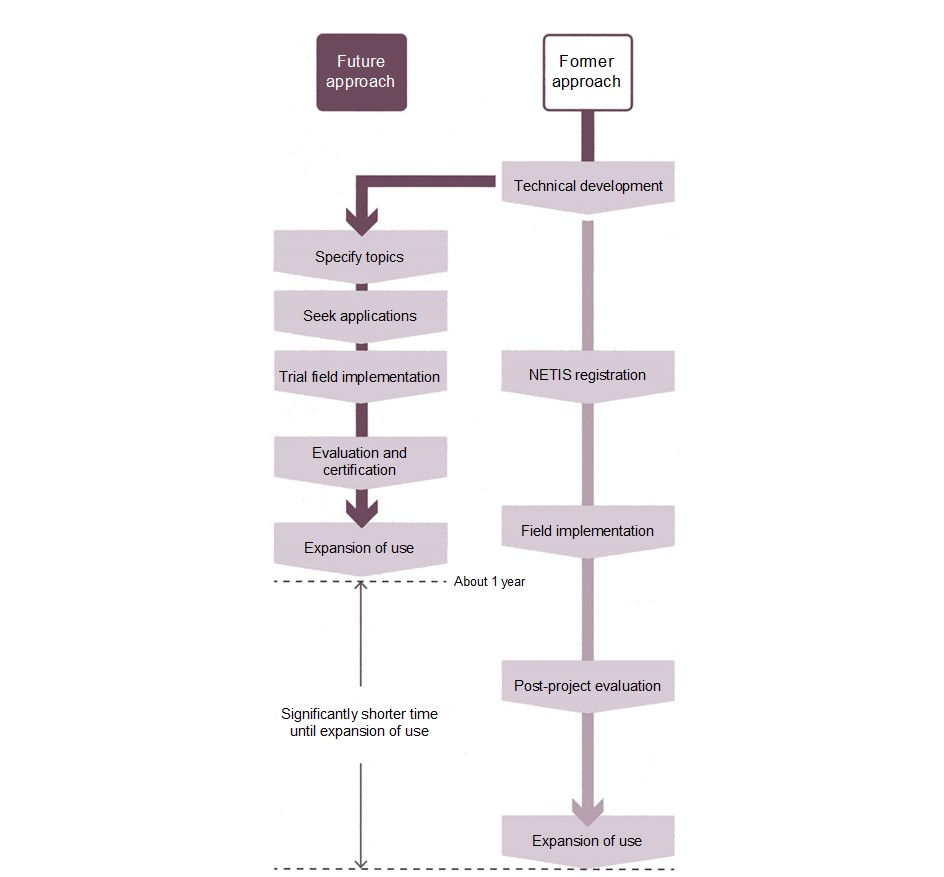Cross-Ministerial Strategic Innovation Promotion Program (SIP)

Daizo YOSHIOKA
Member; Director for Environment, Safety, Geospatial Information and Engineering Affairs, Engineering Affairs Division, Minister's Secretariat, Ministry of Land, Infrastructure, Transport and Tourism
Current status of infrastructure maintenance
and necessity of technical development
In May 2014, the
Ministry of Land, Infrastructure, Transport and Tourism (MLIT)
announced its plan on extending the lifespan of infrastructure,
which is an action plan for strategic maintenance and renovation
of roads, rivers, harbors, sewer systems, and other
infrastructure under its jurisdiction, and is pursuing steps
such as preparing maintenance and inspection manuals in each
area and developing plans for individual facilities.
Development of new technologies in infrastructure maintenance
In the SIP Infrastructure Program, 60 R&D projects are underway on the five topics of inspection and diagnostics technologies, materials and repair technologies, information and communications, robotics, and asset management technologies. Of these, MLIT is conducting technical development and field verification in 23 projects involving robotics for infrastructure, in addition to inspection and diagnostics technologies in the five areas of bridges, slopes, embankments, harbors, and airports, including the use of drones for bridge pier and floor slab inspection by photography and image analysis, the use of tilt sensors for slope displacement measurement and risk assessment, and the use of lasers and satellites to measure displacement in embankments and dams. Three years have passed (as of June 2017) since the launch of SIP infrastructure projects, and the emphasis is expected to shift to the stage of implementation with regard to useful elemental technologies. In order to steadily advance implementation, it is necessary to promote the evaluation and certification of useful technologies through accuracy validation in order to determine whether these technologies provide the required performance that administrators are seeking at actual sites that are subject to differing weather conditions and installation environments, as well as comparison with similar technologies including their relative costs.
Faster progress from technical development to implementation: Utilization of new technologies based on NETIS
MLIT operates the New Technology Information System (NETIS), a database of technologies developed by parties such as private businesses. In the past, MLIT has promoted the practical application of these new technologies by means such as developing maintenance support sites and providing post-project evaluation of the results of utilization (recommended technologies, etc.). Starting in FY 2016, MLIT began taking steps to speed up implementation without waiting for applications from developers, by implementing the following series of steps: [1] seeking applications for new technologies on a particular topic and specifying the performance requirements sought by MLIT as administrator; [2] investigation of trial implementation of technologies for which applications are received; [3] confirmation that performance requirements are met and comparative evaluation with similar technologies; and [4] active utilization of confirmed technologies by orderers. (Fig. 1).
I believe that this will lead to significant reduction in the length of time from application and registration with NETIS to post-project evaluation, practical implementation, and widespread adoption, which has taken up to about four or five years until now, to only about one year.
In FY 2017, we plan to seek applications on a wider range of topics, including technologies to survey cavities under roads and robotic technologies that are capable of creating inspection records.
Directions for future technical development
At the present stage of
technical development for maintenance, robots cannot yet
substitute for inspection and diagnosis by people, and there is
still an imbalance in the usable lifetime of sensors and civil
engineering structures. Meanwhile, steady progress is being made
toward the practical use of new technologies based on
administrators' needs, including sensors to confirm the effects
on durability after repairs, and robots that are capable of
creating inspection records even though they cannot take over
inspection and diagnosis.

Fig. 1. Faster evaluation of new technologies by specifying development topics in NETIS
MLIT is incorporating
the methods of open innovation to actively promote matching
between technological solutions from different fields and the
needs of administrators at venues such as the national
conference on infrastructure maintenance and the i-Construction
promotion consortium. In addition, we will advance the adoption
of cutting-edge technologies by national and regional public
organizations by providing rapid field validation and reflecting
these technologies in standard inspection procedures and other
standards.